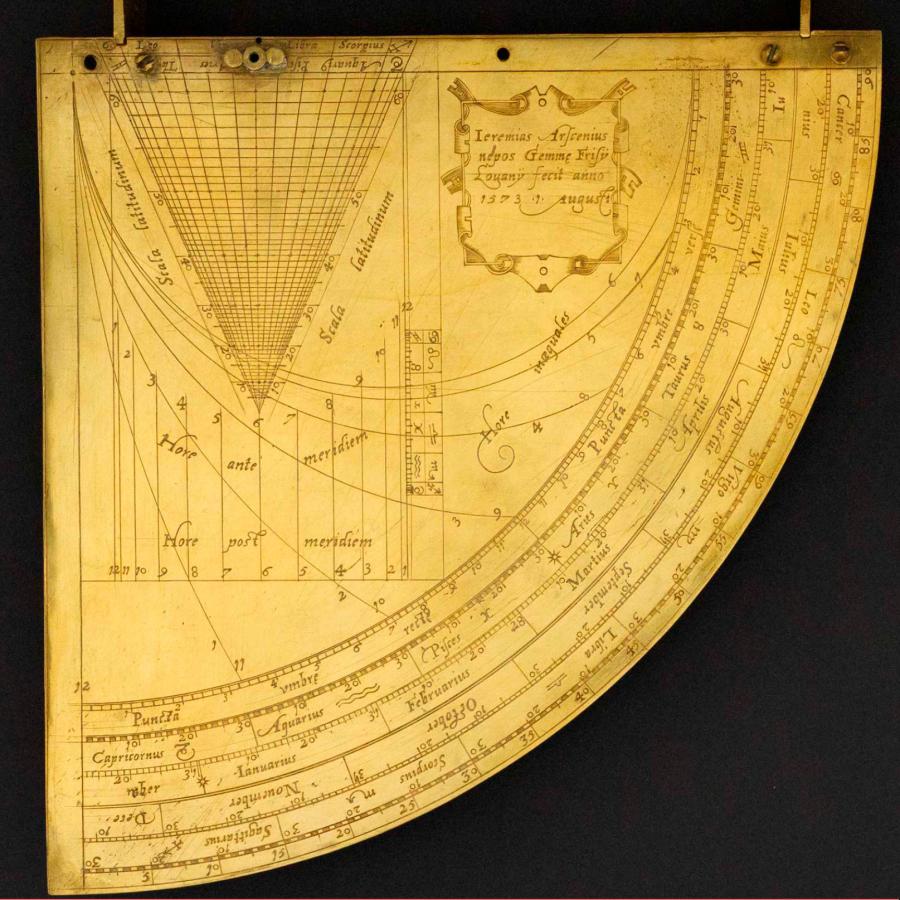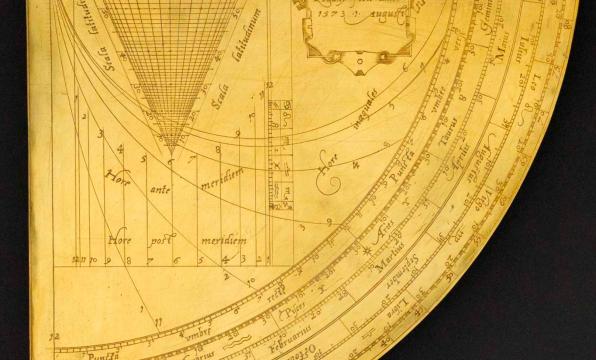
Objeto do mês
No mês em que se celebra o Dia Internacional da Matemática (e do PI), destacamos o quadrante de Arscenius. Datado de 1573, permite medir alturas e distâncias, calcular a altura do Sol (e dos outros 25 astros, cujas posições são projetadas no seu plano), ver as horas de dia e de noite, e estimar a hora de nascer e pôr do sol em qualquer lugar do globo terrestre.
Este instrumento em liga de cobre-zinco, com formato de um quarto de círculo e escalas gravadas a buril, ostenta na orla superior duas pínulas com orifícios, as quais permitem avistar um corpo celeste, ou alinhar este instrumento com um raio de sol e ler a sua altitude na interseção de um fio de prumo (em falta) utilizando a escala de graus. Para o funcionamento das escalas planisféricas, originalmente teria um índice graduado, rotativo, e o mostrador de tipo Regiomontano seria equipado com um braço segmentado (em falta) na extremidade do qual seria fixado um fio de prumo com uma pequena massa deslizante.
O quadrante apresenta também uma assinatura: "Ieremias Arscenius | nepos Gemmę Frisij | Louanij fecit anno | 1573 -1- Augusti", literalmente: “Ieremias Arscenius, um sobrinho de Gemma Frisius, fabricou [isto] em Lovaina no ano de 1573, 1 de agosto”. Ainda não foi referenciado na literatura um fabricante com este nome, mas é possível que esteja associado à oficina de instrumentos de Gualterus Arscenius (d. 1580) em Lovaina, uma das mais prestigiadas da época. Os instrumentos de Arscenius ostentam frequentemente a assinatura “sobrinho de Gemma Frisius (1508-1555)”, referindo-se ao famoso médico e professor de matemática de Lovaina.
Neste quadrante em particular, Ieremias Arscenius combinou ecleticamente instrumentos na mesma peça. Pode demonstrar-se que se trata de um caso notável de utilização de um livro impresso no fabrico de instrumentos, neste caso a “Protomathesis” de Oronce Fine (1531-1532).
Desconhece-se como e quando este instrumento veio de Lovaina para Portugal. Sabe-se que pertenceu às coleções reais, foi referenciado no inventário judicial de julho de 1912 do Palácio da Ajuda, aquando da abolição da monarquia em Portugal. O registo diz o seguinte: “Quarto de circulo, de metal, com differentes circulos Graduados diversamente, com as escalas de altitude e de longitude e a indicação de varias estrellas e dos meses do anno, medindo o raio 0,17.” Em março de 1957, o então diretor do Palácio, Manuel Carlos de Almeida Zagalo, decidiu doar à Escola Comercial Patrício Prazeres um lote de "aparelhos científicos", no qual constava o "Quadrante metálico, para medição de alturas de estrelas", guardado no 'Armário CQ3'. Este instrumento da Escola Comercial Patrício Prazeres encontra-se em depósito no MUHNAC desde 1992.
No âmbito do programa cultural do Museu e do desenvolvimento de atividades a partir do seu acervo, estabeleceu-se uma parceria entre o MUHNAC, o LiDA e o CIUHCT. Desenvolveu-se um modelo simplificado (impresso em 3-D, no Laboratório de Investigação em Design e Artes, Politécnico de Leiria), para podermos explorar algumas escalas e aplicações do quadrante.
ARSCENIU'S ASTROLABE-QUADRANT
In the month of International Maths Day, we highlight the Arscenius quadrant. Dating back to 1573, it allows you to measure heights and distances, calculate the height of the Sun (and the other 25 stars, whose positions are projected onto its plane), see the time of day and night, and estimate the time of sunrise and sunset anywhere on the globe.
Made of copper-zinc alloy with a quarter-circle shape and chiselled scales, this quadrant has two pinules with holes in the upper edge, which make it possible to spot a celestial body, or align the instrument with a sunbeam, and read its altitude at the intersection of a (missing) plumb line using the degree scale. For the operation of the planispheric scales, it would originally have a graduated, rotating index, and the dial of the Regiomontanus type would be equipped with a segmented arm (partially broken off) at the end of which a plumb line with a sliding mass would be attached.
The quadrant also shows a signature: “Ieremias Arscenius | nepos Gemmę Frisij | Louanij fecit anno | 1573 -1- Augusti”, literally: “Ieremias Arscenius, a nephew of Gemma Frisius, made [this] in Leuven in the year 1573, 1st of August”. A maker of this name has not yet been mentioned in the literature, however, he may well be associated with the instrument workshop of Gualterus Arscenius (d. 1580) in Leuven, one of the most prestigious of the time. Arscenius’ instruments often bear the signature “nephew of Gemma Frisius (1508-1555)”, refering to the famous physician and mathematics teacher from Leuven.
On this particular quadrant, Ieremias Arscenius eclectically combined instruments in the same piece. It can be shown that this is a remarkable case of use a printed book in instrument making, in this case the “Protomathesis” by Oronce Fine (1531-1532).
It is unknown how and when this instrument came to Portugal from Leuven. It is known that it belonged to the royal collections and was mentioned in the July 1912 judicial inventory of the Ajuda Palace, when the monarchy was abolished in Portugal. The record reads as follows: “Quarter circle, made of metal, with different circles graded differently, with the altitude and longitude scales and the indication of various stars and the months of the year, measuring a radius of 0.17.” In March 1957, the then director of the Palace, Manuel Carlos de Almeida Zagalo, decided to donate a batch of “scientific apparatus” to the Patrício Prazeres Commercial School, which included the “Metal quadrant for measuring the heights of stars”, kept in the ‘CQ3 cupboard’. This instrument from the Escola Comercial Patrício Prazeres has been in long term deposit at MUHNAC since 1992.
As part of the Museum’s cultural programme and the development of activities based on its collection, a partnership was established between MUHNAC, LiDA and CIUHCT. With the aim of experimentation, a simplified model was developed (Printed in 3-D, Design and Arts Research Laboratory, Polytechnic of Leiria) to explore some of the quadrant’s scales and applications.
Texto de I Text by: Samuel Gessner | CIUHCT-ULisboa / NOVA; Maria do Carmo Elvas | Núcleo Património e Coleções MUHNAC; Anabela Teixeira | Professora de Matemática, Escola Secundária de Camões.
Quadrante de Arscenius | Arscenius’ astrolabe-quadrant
Fabricante I Maker: Ieremias Arscenius, Louvaina, 1573
Proveniência I Provenance: Coleção da Casa Real (1910), Escola Comercial Patrício Prazeres (1957)
Universidade de Lisboa, MUHNAC-UL-DEP0262
PROGRAMA ALARGADO
24 março | 11h00
Oficina de demonstração da utilização e aplicações do quadrante de Arscenius
Venham descobrir e experimentar os modelos 3-D, através de problemas simples e divertidos, explorando o que está à nossa volta.
Atividade destinada a público geral e familiar (com crianças a partir dos 6 anos).
Participação livre.

